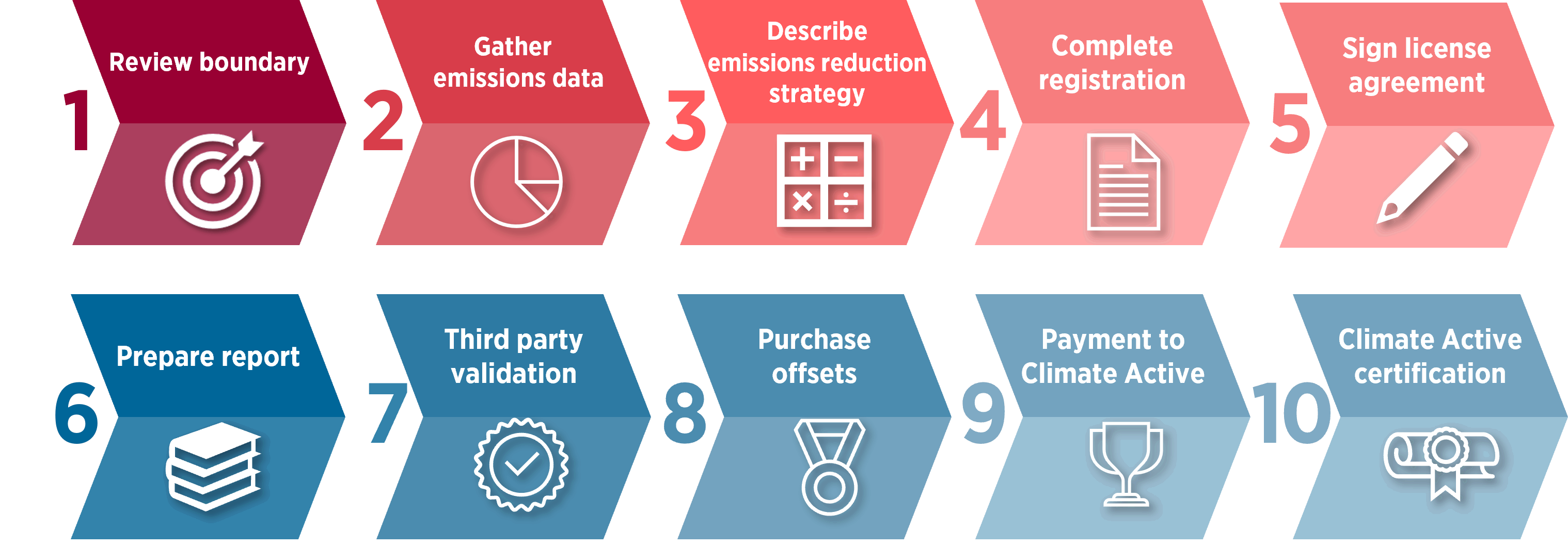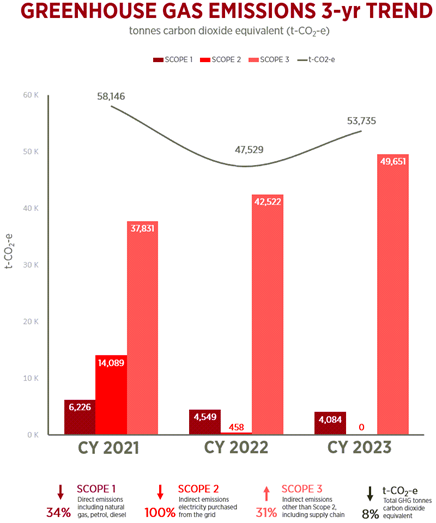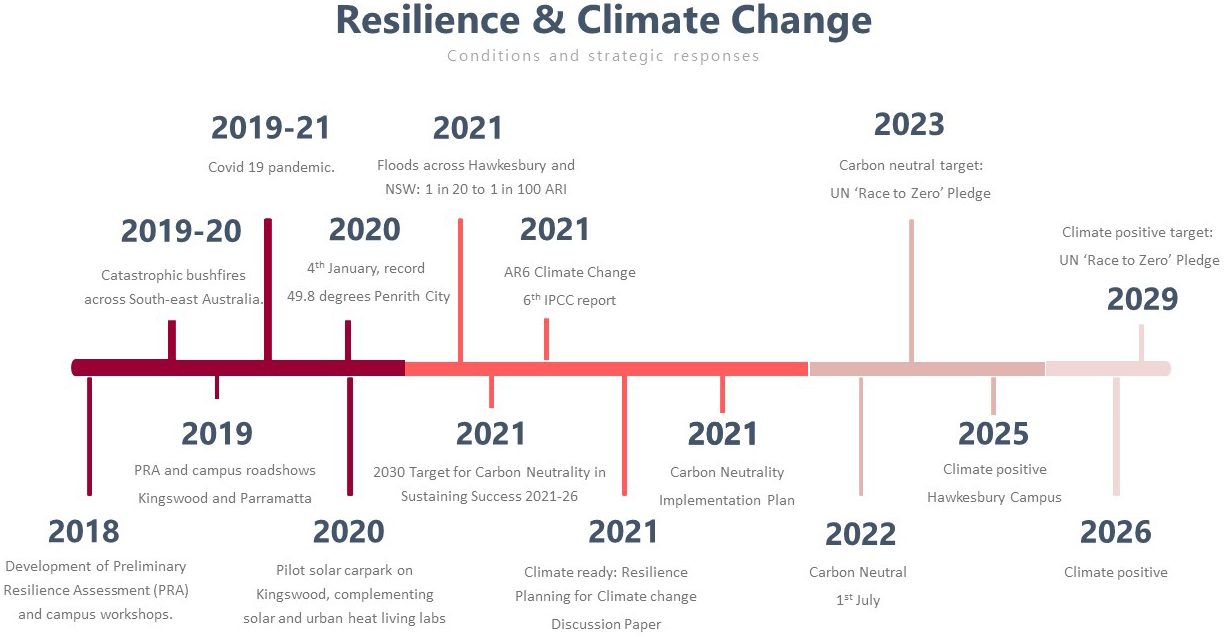1 Climate Action at Western
Dr Roger Attwater[1]
Abstract
Western Sydney University (Western) takes seriously its role in organisational leadership for climate action both through emissions reduction, adaptation planning and engagement through living labs. In late 2021 Western committed to the UN-led “Race to Zero for Colleges and Universities” with bold targets of Carbon Neutral 2023, which has been achieved, and Climate Positive 2029. The strategies developed include Climate Active certification and a 5-Year Carbon Transition Plan. Developing resilience and climate risk planning addresses necessary adaptations to current and emerging climate change impacts. Living labs are a core engagement strategy, utilising campus assets to demonstrate emerging opportunities such as electrification, biodiversity stewardship, and potential carbon farming. These living labs enable fast tracking of student skills to address critical professional shortages. Collaboration is also a key strategy, with advocacy organisations, state government agencies, and with sector and international networking. Pragmatic examples of initiatives across these inter-related aspects will be outlined, along with progress towards organisational and community aspirations.
Keywords
Climate action; Climate adaptation
Organisational strategy and action planning
Here at Western, our responsibilities relating to sustainability and climate action are firmly grounded in our strategic plan, “Sustaining Success – 2021-2026”, and our decadal strategy “, Sustainability and Resilience 2030”. Links between strategy, planning and action are reflected in our Environmental Sustainability Policy and associated Environmental Sustainability Action Plan. The Environmental Sustainability Policy links our strategic and broader social commitments, including embedding the UN Sustainable Development Goals (SDGs) into our CORE model of a sustainable university (Curriculum, Operations, Research and Engagement) (Figure 1). This model informs our governance structure such as our Sustainability and Resilience Decadal Strategy Working Group and associated executive steering committee. The Environmental Sustainability Action Plan includes Resilience and Climate Change as a key theme, with overarching strategies of mitigation through carbon transitions, adaptation through resilience planning and risk management, and integration with teaching and research through campus-based living labs.
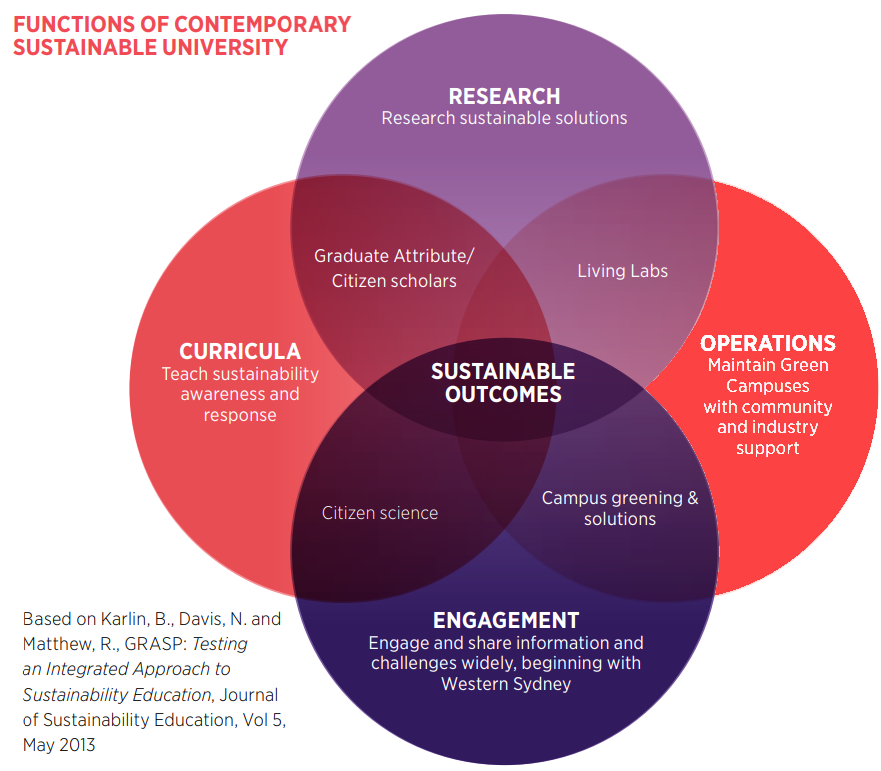 Figure 1. Functions of a contemporary sustainable university[2]
Figure 1. Functions of a contemporary sustainable university[2]
In November 2021, Western committed to the UN-led “Race to Zero for Colleges and Universities” with bold targets of Carbon Neutral 2023 and Climate Positive 2029. With the support of the NSW (New South Wales) Sustainable Advantage program, the consultants 100% Renewables were engaged to prepare our organisational carbon footprint and related requirements for submission to the Australian government’s Climate Active program. Consistent with international GHG (Greenhouse Gas) protocols, our organisational carbon footprint is comprised of emission ‘Scopes’: Scope 1 including fuels, natural gas and refrigerants, Scope 2 including electricity supplied through transmission lines from electricity generation sites, and Scope 3 which includes ‘upstream’ supply chains and broader ‘downstream’ value chain emissions. A significance test was then undertaken to identify key categories of emission sources, particularly for the complex Scope 3. Auditing and validation were required, along with a public statement of an emission reduction strategy. In April 2023, we successfully achieved organisational certification as Carbon Neutral (utilising a combination of steps 3 and 8 in Figure 2), and we have subsequently continued this yearly process of reporting to Climate Active.
Figure 2. Climate Active process (adapted from 100% Renewables[3])
An important outcome of this action was the clear identification and quantification of our organisational carbon footprint as a baseline for mitigation actions based upon carbon transitions (Figure 3). As of 2023, our Carbon Footprint comprises 8% Scope 1 emissions, 0% Scope 2 emissions, and 92% Scope 3 emissions. Within Scope 3, the key emission categories include professional services, construction materials and services, ICT services and equipment and air transport.
Figure 3. Carbon footprint 2021-2023
Carbon transition planning
In early 2023, while awaiting our submission to be assessed by Climate Active, we began to develop a 5-Year Carbon Transition Plan. Building upon an offer of support from an Alumni led to the engagement of Veolia Energy Solutions who applied a ‘carbon engineering’ approach to potential decarbonisation strategies. Stakeholder engagement was sought to contribute to co-design, along with workshopping resultant high-level strategies. The key strategies are outlined in Figure 4 for Scopes 1, 2 and 3.[4]
The key strategy for Scope 1 emission reduction is fuel switching and electrification of assets currently powered by natural gas and other fossil fuels. Natural gas has been a cost-effective fuel source for air conditioning, hot water, and boosters at a range of scales. Central energy plants for facility and large building HVAC (Heating Ventilation and Cooling) commonly use large-scale gas-powered units, with electric heat-pumps utilising alternative refrigerants emerging. For water heaters and boosters for solar hot water, gas has been a common fuel source. The electrification process for these units is complex, with technical changes in large-scale components with long asset life cycles, along with a need to increase electrical capacity to support this transition. The approach currently developing is to utilise Hawkesbury campus as a pilot for engineering re-design which addresses the electrification of these gas powered units at a range of scales.
Transition to electric vehicles (EVs) is another key dimension of this strategy, including replacement of fuel powered fleet vehicles, transportation services such as campus shuttle buses and the supply of chargers for staff and student personal vehicles. Infrastructure strategies for EVs broadly is a challenging landscape with the slow introduction of reliable and accessible organisational and public networks of charging stations along with necessary supporting electrical infrastructure. Western has installed EV chargers on all open campuses, integrated with solar carpark structures and dedicated EV parking spaces. Roll-out of an additional layer of EV pool cars is underway, along with the consideration of future on-site charging for shuttle buses and landscaping equipment. A critical campus strategy is to have charging and electrification transitions underpinned by renewably sourced electricity, either through self-generation or purchase contracts.
Scope 2 emissions relate to electricity delivered through supply contracts along with on-site generation by solar or photovoltaic (PV) panels or other technologies. Western’s supply contracts are with 100% renewably sourced and accredited GreenPower retailers. The transition to market-based renewables has resulted in our reportable Scope 2 emissions falling to zero.
On-site PV generation has been increasingly integrated into our campus buildings and facilities. Rooftop PV continues to be installed where suitable, with the Engineering Precinct at Kingswood reflecting a developing micro-grid demonstration, with 200kW of panels on the roof of Building Z, and an additional 100kW of adjacent solar carpark. Based on the success of this first solar carpark, additional structures have now been rolled out on Hawkesbury, Parramatta South and Campbelltown campuses, integrating local renewable generation with EV charging stations. These structures also address urban heat and safety through design. Carparks are a major urban heat issue in Western Sydney, and the solar carparks provide shading and cooling, enhanced accessible parking in inclement conditions, and shelter from storms. The electrification design underway will also investigate emerging opportunities for strategic on-site battery storage, for energy conservation, critical backup needs and as a component of progress towards a more strategic infrastructure landscape of household, community and organisational battery storage.
Scope 3 is a complex mix of supply chain emissions and potentially broader value chain relationships contributing a significant 92% of our carbon footprint. For Western’s organisational structure, in delivering our tertiary educational services, most Scope 3 emissions relate to ‘upstream’ supply chain, with professional services (32%), construction materials (20%), ICT services and equipment (12%) and air transport (7%), being the major contributors. It also includes difficult-to-quantify emission categories such as commuting, services which are areas of student experience, and food service businesses on our campuses (Figure 5).
Key to reducing Scope 3 emissions is developing an overarching ethical procurement strategy, working with our suppliers as they also undertake their carbon reduction journey and assisting staff as they make their procurement decisions. This work is currently being undertaken with the assistance of NSW Sustainability Advantage.
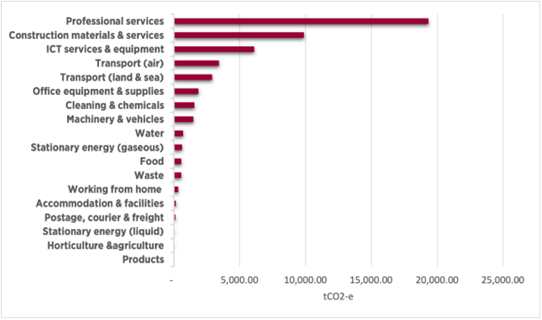 Figure 5. Scope 3 emission categories 2023
Figure 5. Scope 3 emission categories 2023
Associated with the identification of our carbon footprint there are a broad range of socio-economic co-benefits and opportunities for integration (Figure 6), including:
- Resilience planning and risk assessment for adaptation needs for current and emerging climate change risks
- The added dimension of Nature Positive, as a high order strategic goal, and reinforcing the importance of nature-based solutions as part of climate action
- The incorporation of Circular Economy business approaches to support reuse of materials and energy, ideally in higher value uses
- Broader investments and Environmental, Social and Governance (ESG) aspects outside the common boundaries applied for estimating an organisational carbon footprint
- Opportunities for generating carbon credits, through technologies and methodologies which capture carbon
- Needs for increasing data stewardship skills to track and quality assure metrics associated with carbon footprint, and changing methodological expectations
- Engagement approaches such as Living Labs to utilise campus assets and emerging methodologies as key assets for teaching, learning, and research
- Ability to develop management actions for specific greenhouse gases such as methane
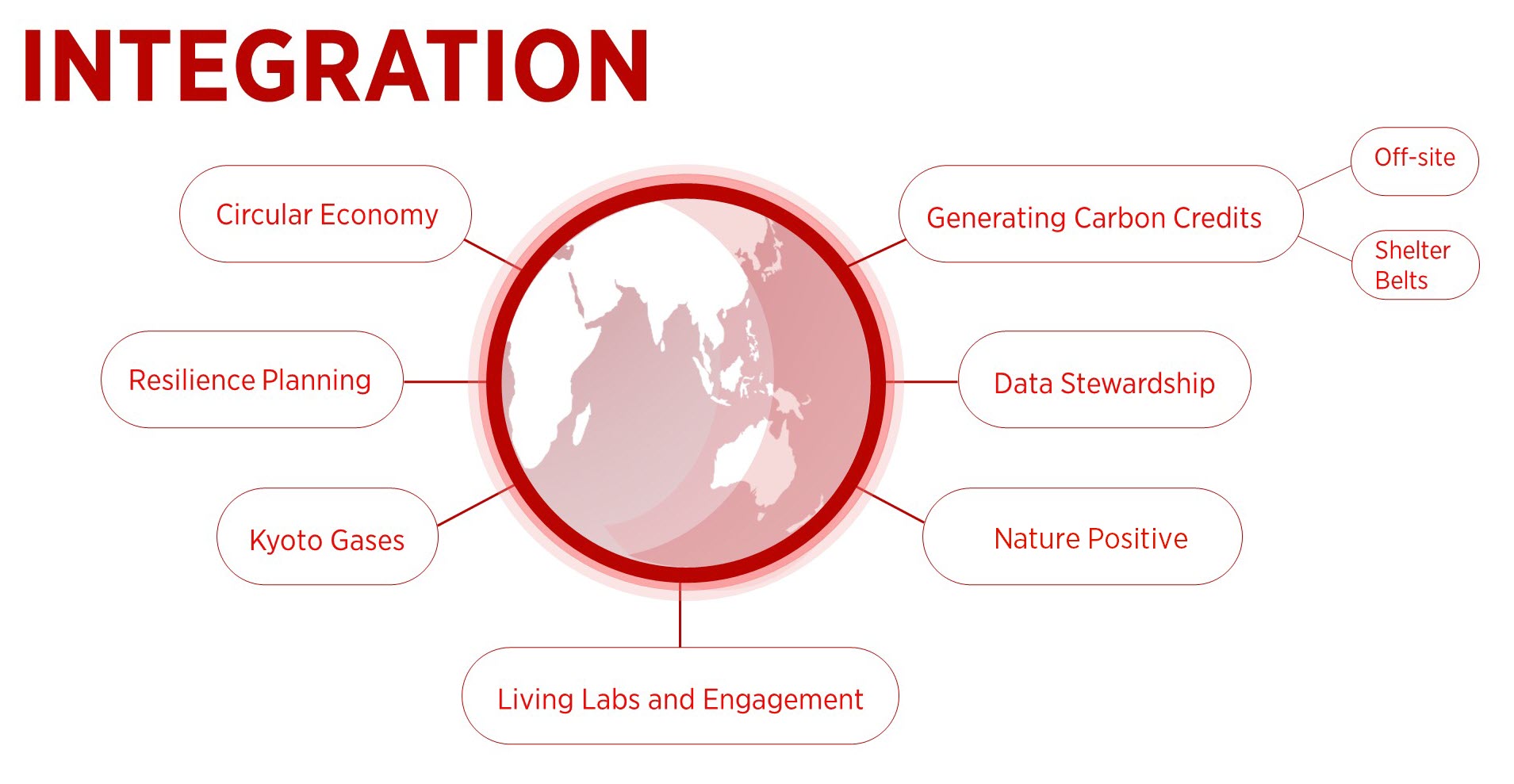
Figure 6. Integration opportunities for climate action
The resilience and adaptation journey
In 2018, we took our first steps towards resilience planning through adapting the model used by Resilient Sydney and based on the Rockefeller Foundation 100 Resilient Cities initiative. This initial step included a preliminary risk assessment of Western’s infrastructure services, compiling strategies underway, and facilitating campus-based workshops in relation to key vulnerabilities, emerging strategies and opportunities for collaboration and action. Key emerging strategies were to: firstly, embed resilience in Western’s strategy and planning, and secondly, to develop integrative infrastructure strategies and interventions (PRA 2019). A core conception of this approach to resilience planning was in avoiding ‘cascading systemic failures’ between systems that seemed not connected at face value.[5] The reality of this threat emerged over the subsequent few years, with the cascading impacts on communities of bushfires across South-East Australia, followed by social isolation and business impacts from COVID, followed by multiple flooding events within the Hawkesbury (Figure 7). The lessons learned from the 2019-2020 bushfires by the CSIRO,[6] reinforced the need for managing resilience as a life cycle, with preparedness and response quickly followed by recovery, incorporating lessons learned in readiness for a next impact. This important perspective, along with proposed responses for global higher education were incorporated in the second stage of our resilience planning journey.[7][8]
Figure 7. Resilience & climate change: conditions and strategic responses.
Across Australia, federal and state initiatives are increasingly requiring organisations to assess risks and impacts of climate and report on financial implication and adaptation strategies. In NSW, the Climate Risk Ready program has been rolled out with government agencies to develop their readiness.[9]
Building upon the establishment of ESG and climate risks in Western’s Enterprise and Divisional risk registers, this NSW Climate Ready process is currently being adapted to Western’s situation; to assess impacts based upon climate risk scenarios, identify physical and transitional risks to the organisation, as a basis for further resilience and adaptation planning.
Living Labs for engagement and social learning
Campus-based living labs have developed as our key engagement strategy for utilising environmental assets across our campuses for teaching, research and engagement. Worldwide, the concept of living labs is becoming more common, utilising campus assets for experiential learning, transdisciplinary research and project-based learning.[10] The broad range of applications of living labs reflects the fluid and contestable nature of this concept, and three key aspects were adopted as a local ‘heuristic’ for defining what our living labs would be. Firstly, use of our campus assets for teaching, learning and engagement relating to sustainability and resilience. Secondly, a multidisciplinary inquiry drawing on different perspectives, and thirdly that the inquiry had some potential greater strategic value be it a potential action toolkit or partnership.
Initial living labs revolved around tactical collaborative inquiry across our campuses. Examples included campus solar generation and an emerging microgrid precinct with electrical engineer on Kingswood campus, videography of natural and cultural heritage with Communication Arts on Parramatta campus, and IoT (Internet of Things) on our Hawkesbury Farm. Further developing cases include collaborative research between our School of Science and Sydney Water on the performance of our stormwater constructed wetlands, and skills development for ecology students in monitoring a biodiversity stewardship site. From these tactical collaborations, recent developments are moving towards strategic clusters of initiatives around cross-cutting themes of climate action, nature-based solutions and circular economy.[11] Western has recently joined the international ‘Joint Declaration on Embracing a Living Lab Approach to Promote Carbon Neutrality’; an initiative by Hong Kong University of Science and Technology for a collective recognition of Universities’ vital role in climate action and using campuses as living labs for hands-on learning and research.[12]
Towards Climate Positive and Nature Positive
Western’s commitment to the UN-led “Race To Zero for Colleges and Universities” is to progress towards a target of Climate Positive 2029, and we are receiving recognition of our, and other universities, efforts so far towards integrating climate action with resilience planning and living labs by the ‘Race to Zero’.[13] An emerging perspective on any claims towards a Climate Positive status is that beyond aggressive decarbonisation, an organisation will need to demonstrate how they are capturing more atmospheric carbon than they are emitting. While there are some emerging technologies for carbon capture, a clear nature-based solution is sequestration by vegetation. An established methodology is that of environmental planting under the federal Clean Energy Regulator and the Carbon Credits (Carbon Farming Initiative) Act 2011, enabling this method to generate high quality Australian Carbon Credit Units (ACCU’s). A developing partnership between Western and Landcare Australia looks to firstly establish a Hawkesbury Carbon Farming Living Lab in 2025. Subsequently it is hoped these first steps can be developed into a broader carbon farming portfolio.
A key emerging strategic goal is ‘Nature Positive’, for which we are currently developing a biodiversity baseline methodology for Western, with potential consideration of a commitment to parallel that of Climate Positive 2029. Currently, income generated from the partial sale of biodiversity credits associated with formal biodiversity stewardship arrangements on Hawkesbury campus is being utilised for purchasing carbon offsets required by our Climate Active certification. Carbon offset projects currently include an Australian project with both biodiversity outcomes and a paired international carbon credit. All our international carbon credit projects focus on technology and nature-based solutions in countries with whom we have established teaching and learning partnerships: Vietnam and Indonesia. This combination of climate and nature-based approaches is expected to become a key integrating strategy for Western going forward.
Additional Resources
Western Sydney University. (2024). Environmental Sustainability. https://westernsydney.edu.au/environmental_sustainability/home
Acknowledgements
My thanks to my Environmental Sustainability team members who have all contributed to the development and ongoing support of the initiatives outlined in this piece, including Dr Lyn Anderson, Jennylee Green and Rachael Mullinger.
SDG Alignment
By demonstrating on our campuses our climate action commitments, which also support teaching and learning engagements, we are practically contributing to this agenda as well as showcasing best practice for our region.
SDG 7 – Affordable and Clean Energy Target 7.2
By 2030, increase substantially the share of renewable energy in the global energy mix
SDG 13 – Climate Action Target 13.3
Improve education, awareness-raising and human and institutional capacity on climate change mitigation, adaptation, impact reduction and early warning
SDG 15- Life on Land
SDG 17 – Partnerships for the Goals
How to Cite this Chapter
Attwater, R. (2025). Climate Action at Western. In Boddington, E., Chandran, B., Dollin, J., Har, J. W., Hayes, K., Kofod, C., Salisbury, F., & Walton, L. (Eds.). Sustainable development without borders: Western Sydney University to the World (2025 ed.). Sydney: Western Sydney University. Available from https://doi.org/10.61588/TESB2263
Attribution
© 2024 Dr Roger Attwater, Director, Environmental Sustainability. This work is licensed under a Creative Commons Attribution-NonCommercial-NoDerivatives 4.0 International License 4.0 https://creativecommons.org/licenses/by-nc-nd/4.0/deed.en. This means you can share this article in its original form, giving appropriate credit to the author, but you cannot use it commercially, modify it, or create derivatives from it.
- Dr Roger Attwater, Western Sydney University, Environmental Sustainability, Office of the Vice-President Operations and Commercial, Australia ↵
- Dr Roger Attwater, Western Sydney University, Environmental Sustainability, Office of the Vice-President Operations and Commercial, Australia ↵
- 100% Renewables (2021) “Western Sydney University– Carbon Neutrality Implementation Plan”, https://westernsydney.edu.au/__data/assets/pdf_file/0011/1881236/Carbon_Neutrality_Implementation_Plan_-_Executive_Summary.pdf ↵
- Veolia Energy Solutions, Environmental Sustainability (2023) Carbon Transition: Discussion Plan, https://westernsydney.edu.au/__data/assets/pdf_file/0011/2007578/Carbon_Transition_Discussion_Paper.pdf ↵
- Resilient Sydney (2016) “Preliminary Resilience Assessment 2016” ↵
- CSIRO (2020) “Climate and disaster resilience”, CSIRO, Australia. ↵
- Facer, K. (2020) “Beyond business as usual: Higher education in the era of climate change”, HEPI Debate Paper 24, Higher Education Policy Institute, Oxford UK. ↵
- Environmental Sustainability (2021) “Climate ready: resilience planning for climate change”, Discussion Paper, OEC, WSU. ↵
- NSW Department of Planning, Industry & Environment (2021) “Climate Risk Ready NSW Guide: Practical guidance for the NSW Government sector to assess and manage climate change risks”, https://www.climatechange.environment.nsw.gov.au/sites/default/files/202106/NSW%20Climate%20risk%20ready%20guide.pdf ↵
- Gomez, T., Derr, V. (2021) “Landscapes as living laboratories for sustainable campus planning and stewardship: A scoping review of approaches and practices”, Landscape and Urban Planning 216 (2021) 104259. ↵
- https://westernsydney.edu.au/environmental_sustainability/living_labs ↵
- https://hkust.edu.hk/global-challenges/sustainable-urban-living/joint-declaration-on-embracing-a-living-lab-approach-to-promote-carbon-neutrality ↵
- https://climatechampions.unfccc.int/universities-leading-the-net-zero-transition/ ↵

